Pattern as Pictorial Art
Mayan Dancer
This piece is composed of 4 large glass panels mounted on a wood base. The work is based on a monochromatic Mayan vase painting from the classic period. The color interpretation was the artist's own.
Each element in the design was separately created by fusing ground glass (frit) in molds.
Elements were overlaid with other elements until the design was complete.
Each panel represents 5 - 6 fusings as colors and design were built up.
Mayan Dancer was exhibited at
North American Glass 2002
Guilford Handcraft Center, CT.
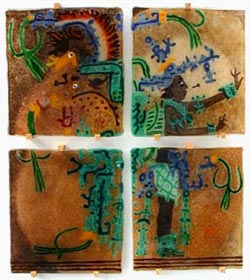
enlarge
Ceremonial Board
This piece of fused glass was inspired by an illustration of an ancient Peruvian 'digging board'. It is dark and slightly mysterious with colors ranging from deep blues to deep greens. The patterns on the glass are defined by raised areas and by sandblasted areas. This piece was built up in many layers using both sheet glass and previously fused sheets made from color gradations of ground glass.
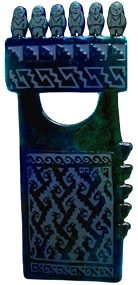
enlarge
Celtic Dogs
Based on an ancient celtic design of two intertwined dogs, this piece was created by adding silver mica to subtly gradated colors of glass frit. The result is a delicate pearlized effect. The design element, created in a mold, is fused to the base but still keeps its raised shape.
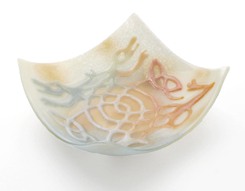
enlarge
Early man recognized his world through stylized patterns called pictographs. They represented the gods, cycles of life and daily living. This mark of ancient peoples bridges history and cultural divides with its powerful imagery.
Blue Warrior
The piece is composed of layers of glass shapes composed of gradated blues that were fused together. An image of a Greek warrior is painted on the back of the piece.
The front reveals the shape of an Athena helmet from the 4th C. b.c. Names of slain Greeks from 424 b.c. are slightly visible on the left front surface. The piece is supported by pieces of broken marble.
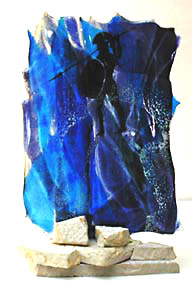
enlarge
Candace Made Me
This piece of fused glass, mounted on red oak, reveals two images from a well-known attic red-figured vase ca. 490 b.c. The image on the back of this piece is painted; the one on the front is sandblasted.
'Candace Made Me' is reproduced in Greek on the left side mimicking the whimsical convention used by ancient potters who signed their work in this manner.
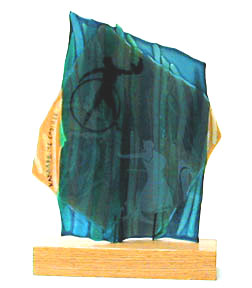
enlarge
